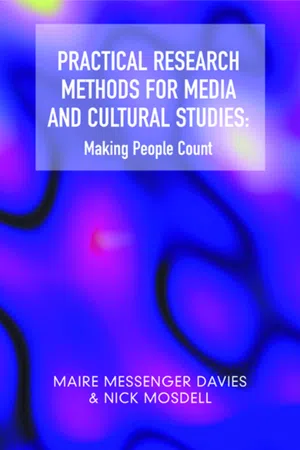
Practical Research Methods for Media and Cultural Studies
Making People Count
- 208 pages
- English
- PDF
- Available on iOS & Android
Practical Research Methods for Media and Cultural Studies
Making People Count
About This Book
Many very intelligent people don't like dealing with numbers. Similarly, many gifted scientists are not especially interested in studying people and their cultural behaviour. In this book, we argue that being interested in people and their cultures, and helping students and others to use numbers to pursue these interests, are not mutually exclusive. Research methods are becoming an increasingly important requirement for students of all kinds. But many students, particularly those in the humanities, struggle with concepts drawn from the social sciences and find quantitative and statistical information inaccessible and daunting. Nonetheless, such concepts are found in nearly all areas of society, from market research and opinion polls to psychological studies of human behaviour. This book aims to provide a simple guide to the process of conducting research in the humanities, with special reference to media and culture, from the planning stage, through the data gathering, to the analysis and interpretation of results: 'planning it', 'doing it' and 'understanding it'. The book aims to show how students' own choice of research topic can be refined into a manageable research question and how the most appropriate methodologies can be applied. Each section draws on actual examples from research that the authors and their students have conducted. Topics covered include: choosing a research question and method; instrument design and pilot data; practical procedures; research with children; looking at statistics; and interpretation of results.Features:*Based on the authors' practical experience as researchers and teachers and is thus accessible, practical and 'how to'.*Includes students' own work as examples.*Bridges the 'divide' between social science and humanities research methods and will therefore appeal to a broad range of students and teachers.
Frequently asked questions
Information
Table of contents
- COVER
- Contents
- Acknowledgements
- PART ONE DESIGN: ‘PLANNING IT’
- CHAPTER 1 Introduction
- CHAPTER 2 What is Your Research Question?
- CHAPTER 3 Choosing a Method
- PART TWO EXECUTION: ‘DOING IT’
- CHAPTER 4 Sampling
- CHAPTER 5 The Practicalities
- CHAPTER 6 Instrument Design: The Questionnaire
- CHAPTER 7 Content Analysis
- CHAPTER 8 Piloting
- CHAPTER 9 Special Audiences – Work with Children
- CHAPTER 10 Data Analysis
- CHAPTER 11 Presenting Results
- CHAPTER 12 Information for Teachers
- CHAPTER 13 Conclusion and Summary
- Bibliography and References
- APPENDICES
- 1. Graphs
- 2. Multiple Responses
- 3. Example SPSS Exercise
- 4. Questionnaire Design Guide
- Index